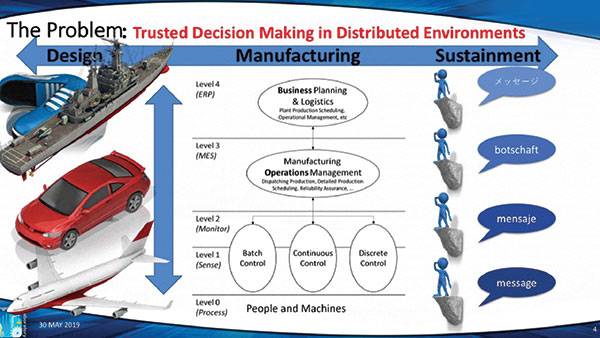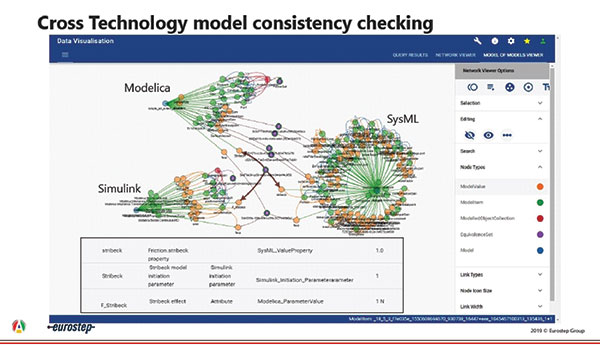Data, Culture Snag Digital Transformation to MBSE
NIST, NASA, DOD dig deep to overcome legacy data and resistance to change in agencies.

Image courtesy of CIMdata.
Latest News
December 1, 2019
Many folks in the product lifecycle management (PLM) world will tell you that moving legacy databases beyond “documents” (paper, Mylar and scans) is a no-brainer, provided that organizations follow the precepts of Model-Based Systems Engineering (MBSE).

Experts in enterprise-class software in U.S. government agencies realize it’s not that easy. These are the people who deal with data and systems engineering practices dating back to the dawn of computing in the 1940s.
The CIMdata PLM Road Map 2019 conference in suburban Washington, D.C., offered a go-slow dose of reality in upgrading basic systems engineering development operations to MBSE in its central role in digital transformation. Government agencies’ problems include dealing with so-called legacy data and resistance to change.
During my presentation at the conference, I noted the consequences within the ongoing disruption of the PLM ecosystem. Practitioners must expand their scope, rethink strategies and capabilities, and embrace the fundamental shifts in PLM requirements and implementations.
Expanding scope may not be enough, however. Business models—the digital enterprise and its positioning, platform strategies, solution offerings—may all have to respond to disruptions including:
- workforce that is digitally savvy, well connected, socially aware and collaborative;
- data migrating out of file formats;
- convergence of configuration management, systems engineering and end-to-end lifecycle thinking;
- radically new technology for engineering and manufacturing such as generative design, additive manufacturing (3D printing) and made-to-order materials; and
- ever-increasing complexity of products and processes plus relentless global competition.

We used to say innovate or die; now we say transform or die. Despite the challenges, the PLM market continues to grow, up 9.4% in 2018.
A Model-Based Approach
Speakers from the National Institute of Standards and Technology (NIST), NASA and the Department of Defense (DOD) reinforced and added to my observations.
NIST often encounters confusion between hype and reality in the digital transformation of manufacturing, especially in success stories about very large enterprises. Small to medium-sized enterprises must be more cautious when going digital; they cannot afford to slow down or disrupt their production processes, NIST believes.
NIST Weighs In
Speaking for NIST was Dr. Thomas Hedberg Jr., P.E., research mechanical engineer. He highlighted the problem of trusted decision making in distributed environments. He noted concerns about the information disconnects among original equipment manufacturers (OEMs) and systems integrators in decentralized manufacturing.
Hedberg pointed out that many small to mid-sized companies (SMBs) cannot afford to completely redesign their manufacturing systems. They need to leverage the capabilities in which they have already invested while adding appropriate new technologies.
Helping them do this is a key NIST goal of its Model-Based Enterprise (MBE) efforts. A significant resource of that effort is NIST’s Smart Manufacturing Systems Test Bed.
“The caution among SMBs should not be misunderstood as a lack of strategic alignment” with digital transformation, Hedberg said. “Technology alone cannot solve these challenges, nor is technology the hardest challenge to address.” The most difficult, he noted, are the human and sociotechnical aspects.
NASA’s MBSE Take
NASA is investigating use of MBSE to supplement or replace elements of its traditional systems engineering approach. Speaking for NASA was Kurt Woodham, a systems engineer at the NASA Langley Research Center in Hampton, VA. MBSE “allows the systems engineer to better focus on engineering the system—understanding technical priorities, risks and opportunities,” he explained.
Challenges in NASA’s move to MBSE from document-based systems engineering include:
- Model metadata stored separately from the model itself, which causes problems in validation, determining provenance, and identifying restrictions and assumptions.
- Networks of systems engineering models that were established prior to design/project decisions and analyses may be inconsistent with the project’s constraints. Examples include networks that combine high fidelity and rudimentary models; mixing models with dissimilar mass calculations for control parameters; and incompatible assumptions or approximations.
- Evolving methods of models and data during the design lifecycles lead to problems in the traceability of significant data through development.
DOD Returns to Fundamentals
The DOD homed in on fundamental questions: What does authoritative data look like? How do we even know if data is authoritative and/or part of the authoritative source of truth? In dealing with legacy data, how do we describe what we do?
The DOD presentation was by Philomena “Phil” Zimmerman, deputy assistant secretary of defense for systems engineering. In her role as the DOD’s technology chief, she pointed out that technology is transforming the battlespace and “we need to change both what we do and how we do it.”
The worldwide proliferation of knowledge and technology erodes historic U.S. advantages, she added, while “our near-peers” are increasing their rate of investment in military R&D. “We cannot expect success fighting tomorrow’s conflicts with yesterday’s weapons or equipment,” Zimmerman pointed out.
This means getting capabilities to warfighters faster with new acquisition pathways and concepts of operation. The DOD itself must be reformed for greater performance and affordability, she continued. “The current bureaucratic approach, centered on exacting thoroughness and minimizing risk above all else, is proving to be increasingly unresponsive” to warfighters’ needs.
Peter A. Bilello is president and CEO of CIMdata Inc. in Ann Arbor, MI. Send email about this commentary to [email protected].
Subscribe to our FREE magazine, FREE email newsletters or both!
Latest News






